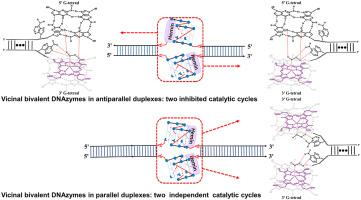Analytica Chimica Acta ( IF 6.2 ) Pub Date : 2022-06-21 , DOI: 10.1016/j.aca.2022.340105 Yanwei Cao 1 , Wenjing Li 1 , Renjun Pei 1

|
G-quadruplex (G4)-hemin complexes are a convenient peroxidase mimicking DNAzyme for utilization in biosensing and analytical applications. Although dispersive G4/hemin DNAzymes have been extensively studied, a thorough investigation of the catalytic mechanism of multivalent G4/hemin (MultiG4) DNAzymes is warranted. To address this, dispersive G4/hemin DNAzymes with high-efficiency are connected by double- or multi-stranded DNA structures to build MultiG4 DNAzymes. The distance and environment of hemin binding sites are regulated by altering the position and spatial orientation of these connected G4s. Our data demonstrate that the catalytic activities of duplex-spaced MultiG4 DNAzymes are not affected by duplex length (within a reasonable range). However, vicinal MultiG4 DNAzymes that are immobilized at small spatial distances by Watson-Crick based DNA structures usually exhibit much lower catalytic activities than dispersive G4/hemin DNAzymes. Our results reveal that increasing the spatial flexibility of vicinal MultiG4 DNAzymes is imperative to achieving high catalytic efficiency. Significantly, we demonstrate that the catalytic activities of vicinal MultiG4 DNAzymes regulated by parallel duplexes are similar to that of dispersive G4/hemin DNAzymes, and that their activities are independent of the proximity effect. Thus, vicinal MultiG4 DNAzymes arranged in the same direction are more conducive to the maintenance of catalytic efficiency than those arranged in opposite directions. Our study provides a perspective for exploring multienzyme catalysis and should contribute to the design of nanozymes with high-efficiency catalytic activities.
中文翻译:

通过调节连接的G-四链体的位置和空间方向探索多价G-四链体/血红素脱氧核糖核酸酶的催化机制
G-四链体 (G4)-血红素复合物是一种方便的过氧化物酶模拟脱氧核糖核酸酶,可用于生物传感和分析应用。尽管分散的 G4/hemin DNAzymes 已被广泛研究,但有必要对多价 G4/hemin (MultiG4) DNAzymes 的催化机制进行彻底研究。为了解决这个问题,高效分散的 G4/hemin DNAzymes 通过双链或多链 DNA 结构连接以构建 MultiG4 DNAzymes。通过改变这些连接的 G4 的位置和空间方向来调节血红素结合位点的距离和环境。我们的数据表明,双链体间隔的 MultiG4 DNAzyme 的催化活性不受双链体长度的影响(在合理范围内)。然而,由基于 Watson-Crick 的 DNA 结构固定在小空间距离的邻位 MultiG4 DNAzyme 通常表现出比分散 G4/hemin DNAzyme 低得多的催化活性。我们的研究结果表明,增加邻位 MultiG4 DNAzymes 的空间灵活性对于实现高催化效率是必不可少的。重要的是,我们证明由平行双链体调节的邻位 MultiG4 DNAzymes 的催化活性与分散 G4/hemin DNAzymes 的催化活性相似,并且它们的活性与邻近效应无关。因此,以相同方向排列的邻位MultiG4 DNA酶比以相反方向排列的那些更有利于维持催化效率。


























 京公网安备 11010802027423号
京公网安备 11010802027423号